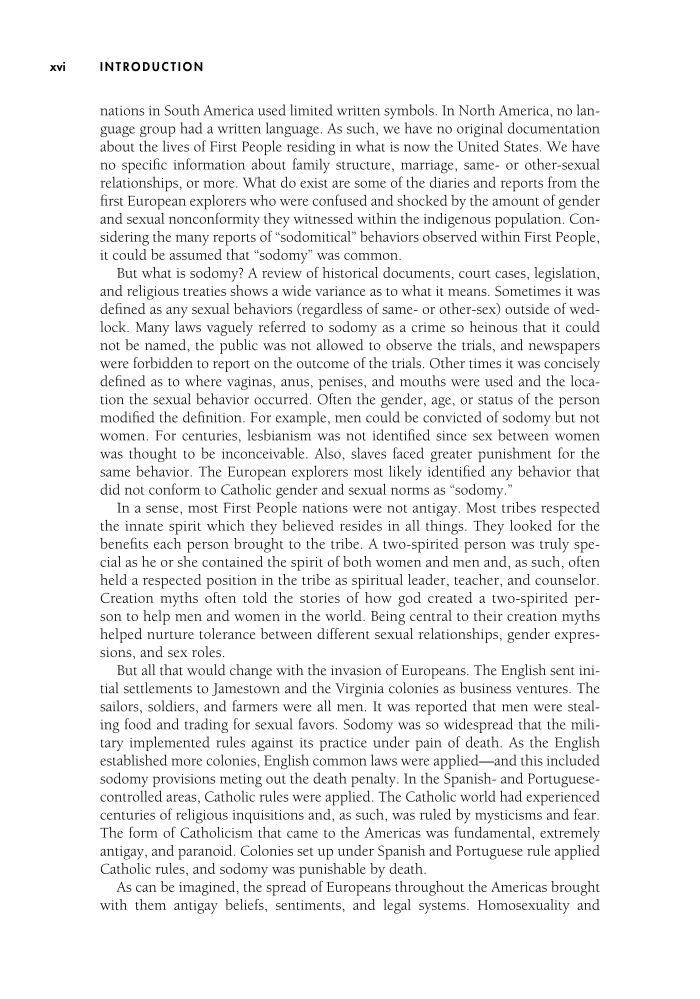xvi INTRODUCTION nations in South America used limited written symbols. In North America, no lan- guage group had a written language. As such, we have no original documentation about the lives of First People residing in what is now the United States. We have no specifi c information about family structure, marriage, same- or other-sexual relationships, or more. What do exist are some of the diaries and reports from the fi rst European explorers who were confused and shocked by the amount of gender and sexual nonconformity they witnessed within the indigenous population. Con- sidering the many reports of “sodomitical” behaviors observed within First People, it could be assumed that “sodomy” was common. But what is sodomy? A review of historical documents, court cases, legislation, and religious treaties shows a wide variance as to what it means. Sometimes it was defi ned as any sexual behaviors (regardless of same- or other-sex) outside of wed- lock. Many laws vaguely referred to sodomy as a crime so heinous that it could not be named, the public was not allowed to observe the trials, and newspapers were forbidden to report on the outcome of the trials. Other times it was concisely defi ned as to where vaginas, anus, penises, and mouths were used and the loca- tion the sexual behavior occurred. Often the gender, age, or status of the person modifi ed the defi nition. For example, men could be convicted of sodomy but not women. For centuries, lesbianism was not identifi ed since sex between women was thought to be inconceivable. Also, slaves faced greater punishment for the same behavior. The European explorers most likely identifi ed any behavior that did not conform to Catholic gender and sexual norms as “sodomy.” In a sense, most First People nations were not antigay. Most tribes respected the innate spirit which they believed resides in all things. They looked for the benefi ts each person brought to the tribe. A two-spirited person was truly spe- cial as he or she contained the spirit of both women and men and, as such, often held a respected position in the tribe as spiritual leader, teacher, and counselor. Creation myths often told the stories of how god created a two-spirited per- son to help men and women in the world. Being central to their creation myths helped nurture tolerance between different sexual relationships, gender expres- sions, and sex roles. But all that would change with the invasion of Europeans. The English sent ini- tial settlements to Jamestown and the Virginia colonies as business ventures. The sailors, soldiers, and farmers were all men. It was reported that men were steal- ing food and trading for sexual favors. Sodomy was so widespread that the mili- tary implemented rules against its practice under pain of death. As the English established more colonies, English common laws were applied—and this included sodomy provisions meting out the death penalty. In the Spanish- and Portuguese- controlled areas, Catholic rules were applied. The Catholic world had experienced centuries of religious inquisitions and, as such, was ruled by mysticisms and fear. The form of Catholicism that came to the Americas was fundamental, extremely antigay, and paranoid. Colonies set up under Spanish and Portuguese rule applied Catholic rules, and sodomy was punishable by death. As can be imagined, the spread of Europeans throughout the Americas brought with them antigay beliefs, sentiments, and legal systems. Homosexuality and
Document Details My Account Print multiple pages
Print
You have printed 0 times in the last 24 hours.
Your print count will reset on at .
You may print 0 more time(s) before then.
You may print a maximum of 0 pages at a time.












































































































































































































































































































